Global Professional Development
VerifiedAdded on 2023/04/21
|15
|4211
|421
AI Summary
This report discusses the assignment on global professional development and provides recommendations and implementation strategies for CML. It analyzes the company's strategic position, environment analysis, and provides insights on leadership and communication. The report also suggests recommendations for improvement and discusses their implementation.
Contribute Materials
Your contribution can guide someone’s learning journey. Share your
documents today.
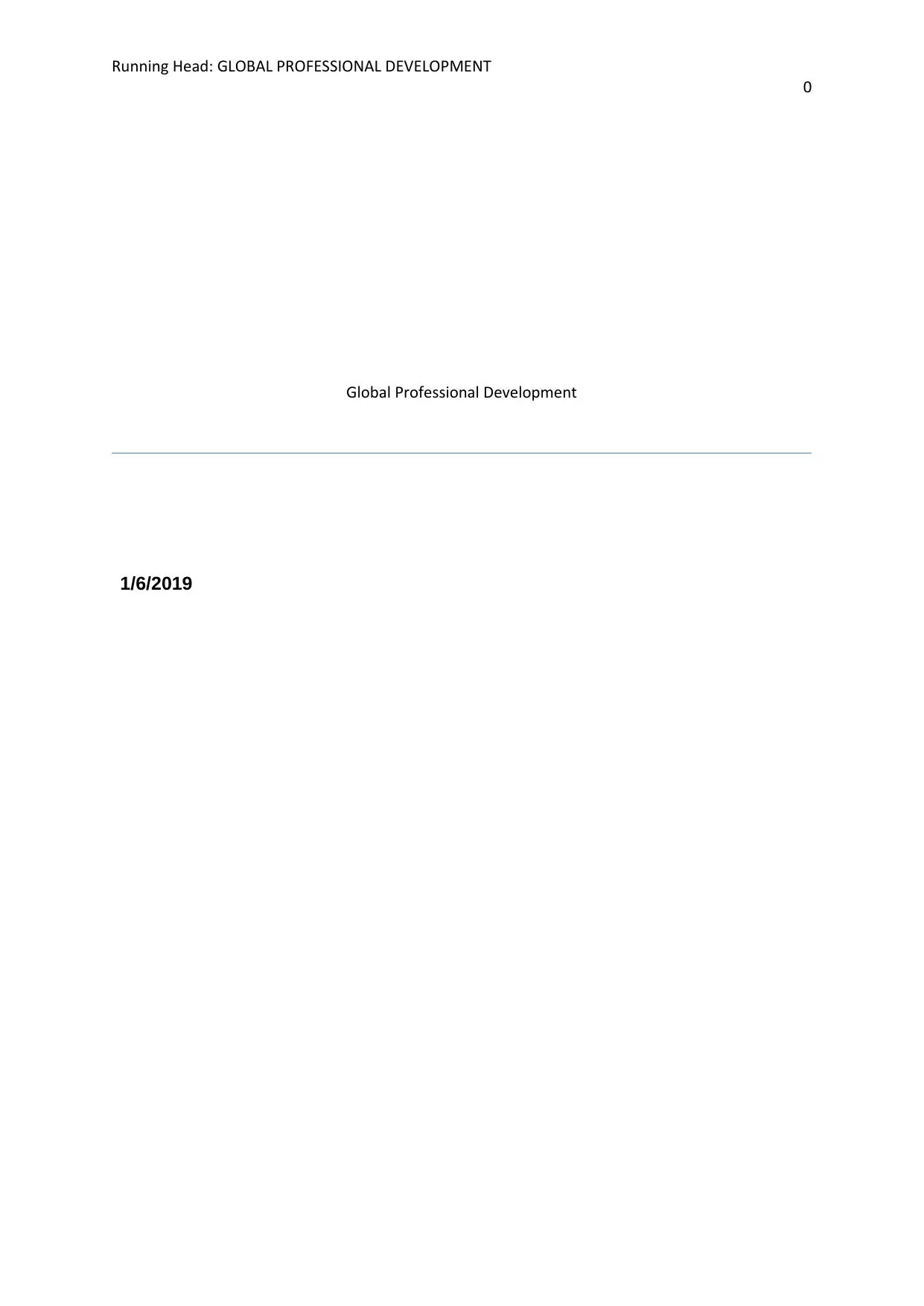
Running Head: GLOBAL PROFESSIONAL DEVELOPMENT
0
Global Professional Development
1/6/2019
0
Global Professional Development
1/6/2019
Secure Best Marks with AI Grader
Need help grading? Try our AI Grader for instant feedback on your assignments.
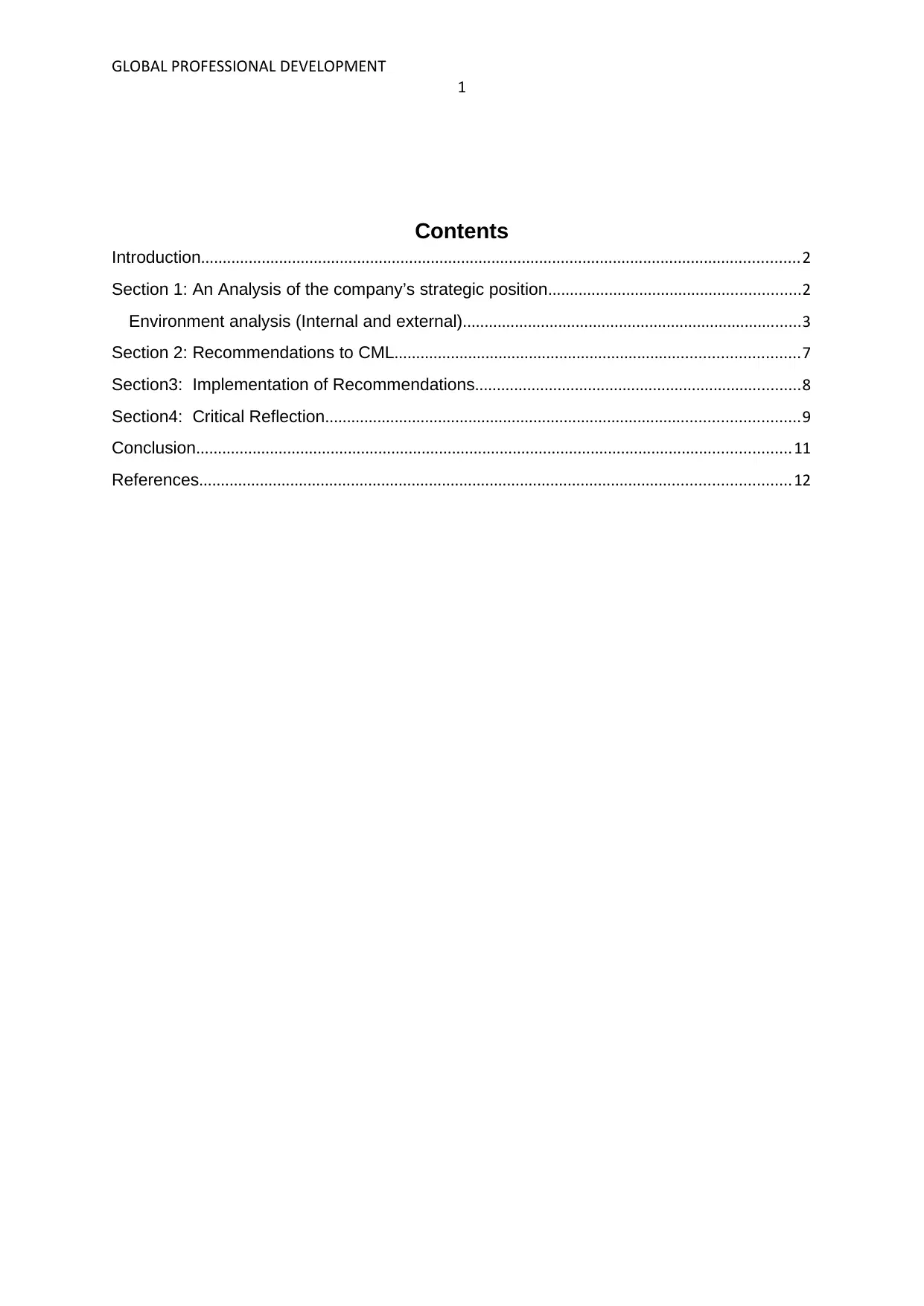
GLOBAL PROFESSIONAL DEVELOPMENT
1
Contents
Introduction..........................................................................................................................................2
Section 1: An Analysis of the company’s strategic position..........................................................2
Environment analysis (Internal and external)..............................................................................3
Section 2: Recommendations to CML.............................................................................................7
Section3: Implementation of Recommendations...........................................................................8
Section4: Critical Reflection.............................................................................................................9
Conclusion.........................................................................................................................................11
References........................................................................................................................................12
1
Contents
Introduction..........................................................................................................................................2
Section 1: An Analysis of the company’s strategic position..........................................................2
Environment analysis (Internal and external)..............................................................................3
Section 2: Recommendations to CML.............................................................................................7
Section3: Implementation of Recommendations...........................................................................8
Section4: Critical Reflection.............................................................................................................9
Conclusion.........................................................................................................................................11
References........................................................................................................................................12
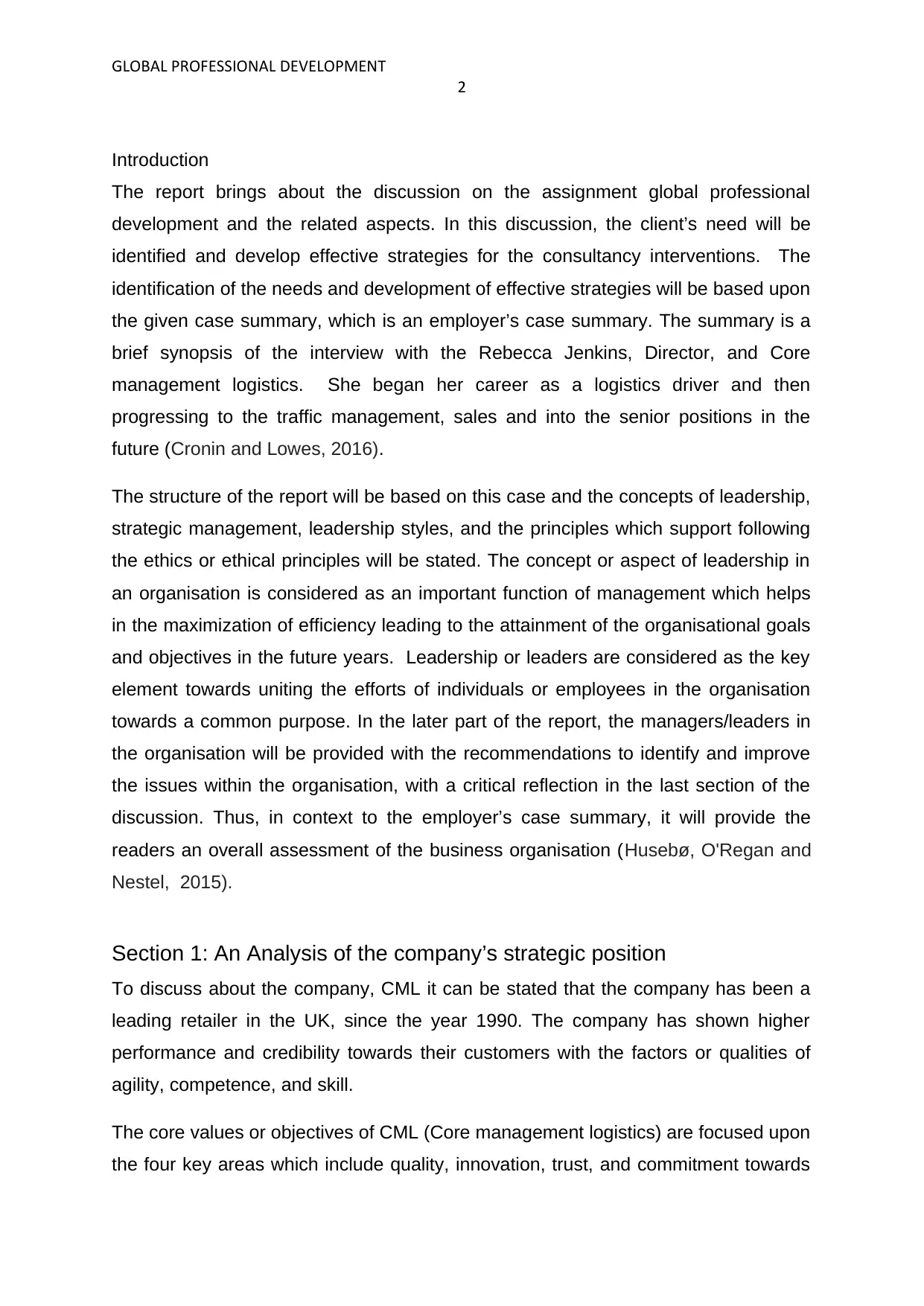
GLOBAL PROFESSIONAL DEVELOPMENT
2
Introduction
The report brings about the discussion on the assignment global professional
development and the related aspects. In this discussion, the client’s need will be
identified and develop effective strategies for the consultancy interventions. The
identification of the needs and development of effective strategies will be based upon
the given case summary, which is an employer’s case summary. The summary is a
brief synopsis of the interview with the Rebecca Jenkins, Director, and Core
management logistics. She began her career as a logistics driver and then
progressing to the traffic management, sales and into the senior positions in the
future (Cronin and Lowes, 2016).
The structure of the report will be based on this case and the concepts of leadership,
strategic management, leadership styles, and the principles which support following
the ethics or ethical principles will be stated. The concept or aspect of leadership in
an organisation is considered as an important function of management which helps
in the maximization of efficiency leading to the attainment of the organisational goals
and objectives in the future years. Leadership or leaders are considered as the key
element towards uniting the efforts of individuals or employees in the organisation
towards a common purpose. In the later part of the report, the managers/leaders in
the organisation will be provided with the recommendations to identify and improve
the issues within the organisation, with a critical reflection in the last section of the
discussion. Thus, in context to the employer’s case summary, it will provide the
readers an overall assessment of the business organisation (Husebø, O'Regan and
Nestel, 2015).
Section 1: An Analysis of the company’s strategic position
To discuss about the company, CML it can be stated that the company has been a
leading retailer in the UK, since the year 1990. The company has shown higher
performance and credibility towards their customers with the factors or qualities of
agility, competence, and skill.
The core values or objectives of CML (Core management logistics) are focused upon
the four key areas which include quality, innovation, trust, and commitment towards
2
Introduction
The report brings about the discussion on the assignment global professional
development and the related aspects. In this discussion, the client’s need will be
identified and develop effective strategies for the consultancy interventions. The
identification of the needs and development of effective strategies will be based upon
the given case summary, which is an employer’s case summary. The summary is a
brief synopsis of the interview with the Rebecca Jenkins, Director, and Core
management logistics. She began her career as a logistics driver and then
progressing to the traffic management, sales and into the senior positions in the
future (Cronin and Lowes, 2016).
The structure of the report will be based on this case and the concepts of leadership,
strategic management, leadership styles, and the principles which support following
the ethics or ethical principles will be stated. The concept or aspect of leadership in
an organisation is considered as an important function of management which helps
in the maximization of efficiency leading to the attainment of the organisational goals
and objectives in the future years. Leadership or leaders are considered as the key
element towards uniting the efforts of individuals or employees in the organisation
towards a common purpose. In the later part of the report, the managers/leaders in
the organisation will be provided with the recommendations to identify and improve
the issues within the organisation, with a critical reflection in the last section of the
discussion. Thus, in context to the employer’s case summary, it will provide the
readers an overall assessment of the business organisation (Husebø, O'Regan and
Nestel, 2015).
Section 1: An Analysis of the company’s strategic position
To discuss about the company, CML it can be stated that the company has been a
leading retailer in the UK, since the year 1990. The company has shown higher
performance and credibility towards their customers with the factors or qualities of
agility, competence, and skill.
The core values or objectives of CML (Core management logistics) are focused upon
the four key areas which include quality, innovation, trust, and commitment towards
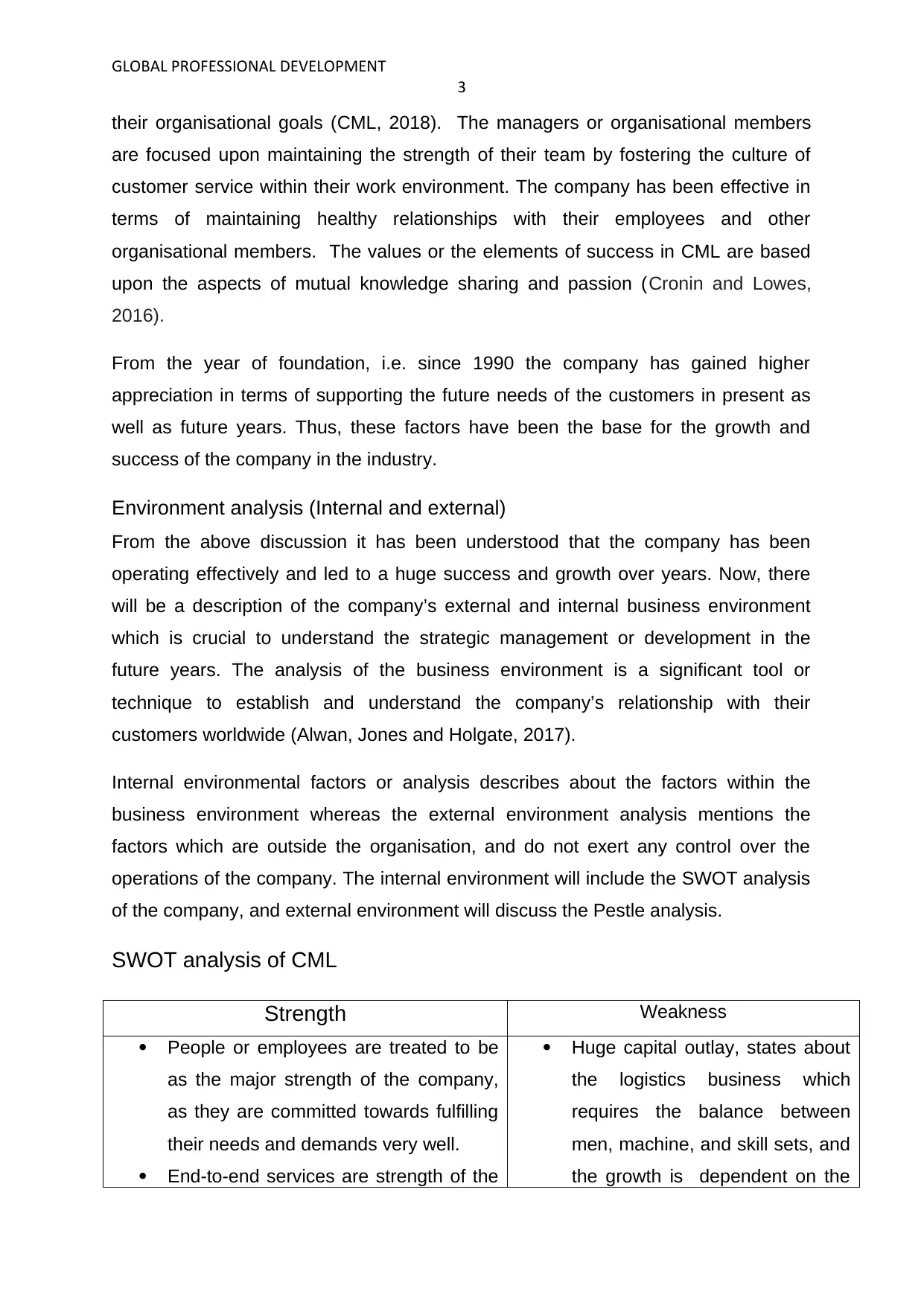
GLOBAL PROFESSIONAL DEVELOPMENT
3
their organisational goals (CML, 2018). The managers or organisational members
are focused upon maintaining the strength of their team by fostering the culture of
customer service within their work environment. The company has been effective in
terms of maintaining healthy relationships with their employees and other
organisational members. The values or the elements of success in CML are based
upon the aspects of mutual knowledge sharing and passion (Cronin and Lowes,
2016).
From the year of foundation, i.e. since 1990 the company has gained higher
appreciation in terms of supporting the future needs of the customers in present as
well as future years. Thus, these factors have been the base for the growth and
success of the company in the industry.
Environment analysis (Internal and external)
From the above discussion it has been understood that the company has been
operating effectively and led to a huge success and growth over years. Now, there
will be a description of the company’s external and internal business environment
which is crucial to understand the strategic management or development in the
future years. The analysis of the business environment is a significant tool or
technique to establish and understand the company’s relationship with their
customers worldwide (Alwan, Jones and Holgate, 2017).
Internal environmental factors or analysis describes about the factors within the
business environment whereas the external environment analysis mentions the
factors which are outside the organisation, and do not exert any control over the
operations of the company. The internal environment will include the SWOT analysis
of the company, and external environment will discuss the Pestle analysis.
SWOT analysis of CML
Strength Weakness
People or employees are treated to be
as the major strength of the company,
as they are committed towards fulfilling
their needs and demands very well.
End-to-end services are strength of the
Huge capital outlay, states about
the logistics business which
requires the balance between
men, machine, and skill sets, and
the growth is dependent on the
3
their organisational goals (CML, 2018). The managers or organisational members
are focused upon maintaining the strength of their team by fostering the culture of
customer service within their work environment. The company has been effective in
terms of maintaining healthy relationships with their employees and other
organisational members. The values or the elements of success in CML are based
upon the aspects of mutual knowledge sharing and passion (Cronin and Lowes,
2016).
From the year of foundation, i.e. since 1990 the company has gained higher
appreciation in terms of supporting the future needs of the customers in present as
well as future years. Thus, these factors have been the base for the growth and
success of the company in the industry.
Environment analysis (Internal and external)
From the above discussion it has been understood that the company has been
operating effectively and led to a huge success and growth over years. Now, there
will be a description of the company’s external and internal business environment
which is crucial to understand the strategic management or development in the
future years. The analysis of the business environment is a significant tool or
technique to establish and understand the company’s relationship with their
customers worldwide (Alwan, Jones and Holgate, 2017).
Internal environmental factors or analysis describes about the factors within the
business environment whereas the external environment analysis mentions the
factors which are outside the organisation, and do not exert any control over the
operations of the company. The internal environment will include the SWOT analysis
of the company, and external environment will discuss the Pestle analysis.
SWOT analysis of CML
Strength Weakness
People or employees are treated to be
as the major strength of the company,
as they are committed towards fulfilling
their needs and demands very well.
End-to-end services are strength of the
Huge capital outlay, states about
the logistics business which
requires the balance between
men, machine, and skill sets, and
the growth is dependent on the
Secure Best Marks with AI Grader
Need help grading? Try our AI Grader for instant feedback on your assignments.
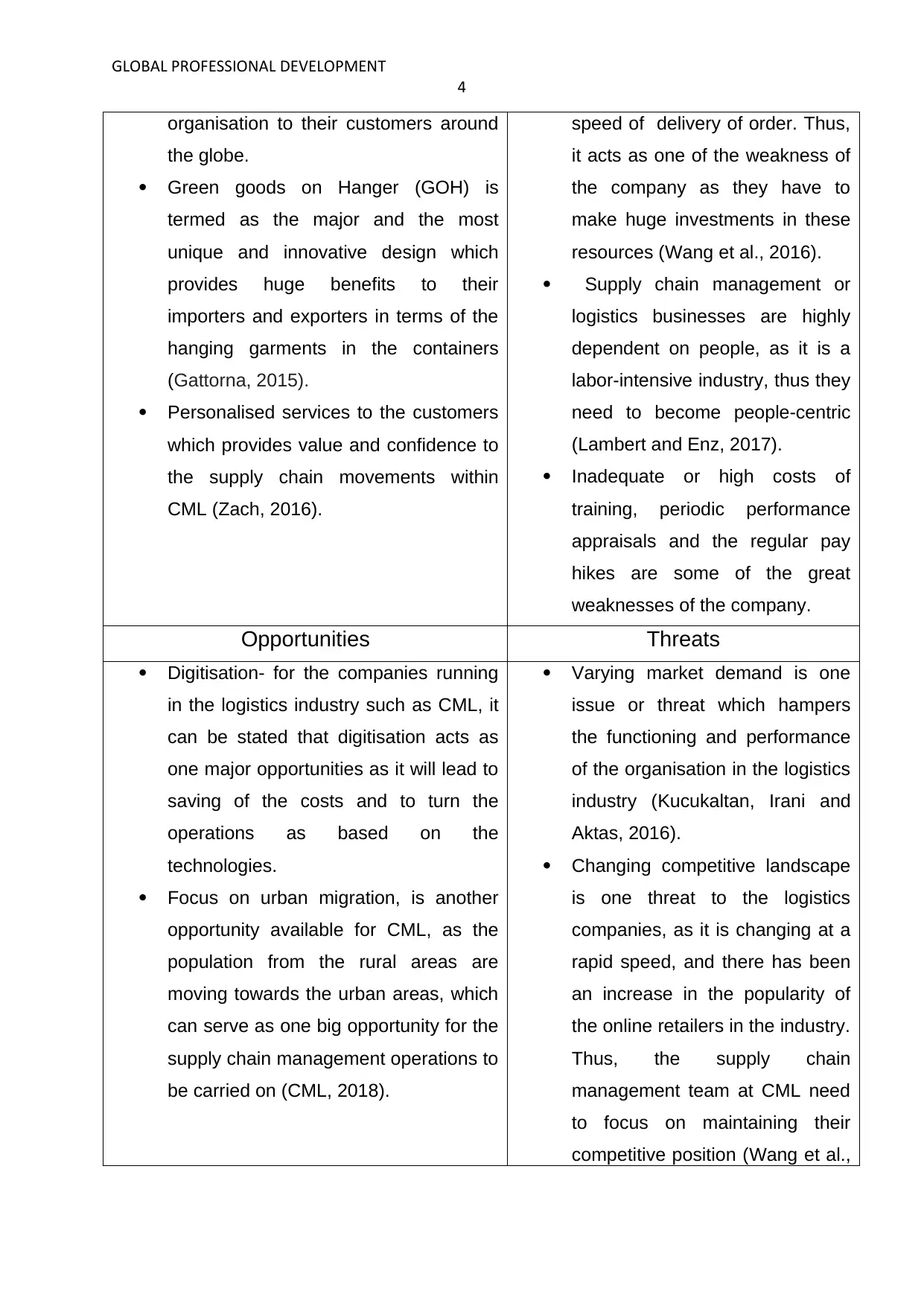
GLOBAL PROFESSIONAL DEVELOPMENT
4
organisation to their customers around
the globe.
Green goods on Hanger (GOH) is
termed as the major and the most
unique and innovative design which
provides huge benefits to their
importers and exporters in terms of the
hanging garments in the containers
(Gattorna, 2015).
Personalised services to the customers
which provides value and confidence to
the supply chain movements within
CML (Zach, 2016).
speed of delivery of order. Thus,
it acts as one of the weakness of
the company as they have to
make huge investments in these
resources (Wang et al., 2016).
Supply chain management or
logistics businesses are highly
dependent on people, as it is a
labor-intensive industry, thus they
need to become people-centric
(Lambert and Enz, 2017).
Inadequate or high costs of
training, periodic performance
appraisals and the regular pay
hikes are some of the great
weaknesses of the company.
Opportunities Threats
Digitisation- for the companies running
in the logistics industry such as CML, it
can be stated that digitisation acts as
one major opportunities as it will lead to
saving of the costs and to turn the
operations as based on the
technologies.
Focus on urban migration, is another
opportunity available for CML, as the
population from the rural areas are
moving towards the urban areas, which
can serve as one big opportunity for the
supply chain management operations to
be carried on (CML, 2018).
Varying market demand is one
issue or threat which hampers
the functioning and performance
of the organisation in the logistics
industry (Kucukaltan, Irani and
Aktas, 2016).
Changing competitive landscape
is one threat to the logistics
companies, as it is changing at a
rapid speed, and there has been
an increase in the popularity of
the online retailers in the industry.
Thus, the supply chain
management team at CML need
to focus on maintaining their
competitive position (Wang et al.,
4
organisation to their customers around
the globe.
Green goods on Hanger (GOH) is
termed as the major and the most
unique and innovative design which
provides huge benefits to their
importers and exporters in terms of the
hanging garments in the containers
(Gattorna, 2015).
Personalised services to the customers
which provides value and confidence to
the supply chain movements within
CML (Zach, 2016).
speed of delivery of order. Thus,
it acts as one of the weakness of
the company as they have to
make huge investments in these
resources (Wang et al., 2016).
Supply chain management or
logistics businesses are highly
dependent on people, as it is a
labor-intensive industry, thus they
need to become people-centric
(Lambert and Enz, 2017).
Inadequate or high costs of
training, periodic performance
appraisals and the regular pay
hikes are some of the great
weaknesses of the company.
Opportunities Threats
Digitisation- for the companies running
in the logistics industry such as CML, it
can be stated that digitisation acts as
one major opportunities as it will lead to
saving of the costs and to turn the
operations as based on the
technologies.
Focus on urban migration, is another
opportunity available for CML, as the
population from the rural areas are
moving towards the urban areas, which
can serve as one big opportunity for the
supply chain management operations to
be carried on (CML, 2018).
Varying market demand is one
issue or threat which hampers
the functioning and performance
of the organisation in the logistics
industry (Kucukaltan, Irani and
Aktas, 2016).
Changing competitive landscape
is one threat to the logistics
companies, as it is changing at a
rapid speed, and there has been
an increase in the popularity of
the online retailers in the industry.
Thus, the supply chain
management team at CML need
to focus on maintaining their
competitive position (Wang et al.,
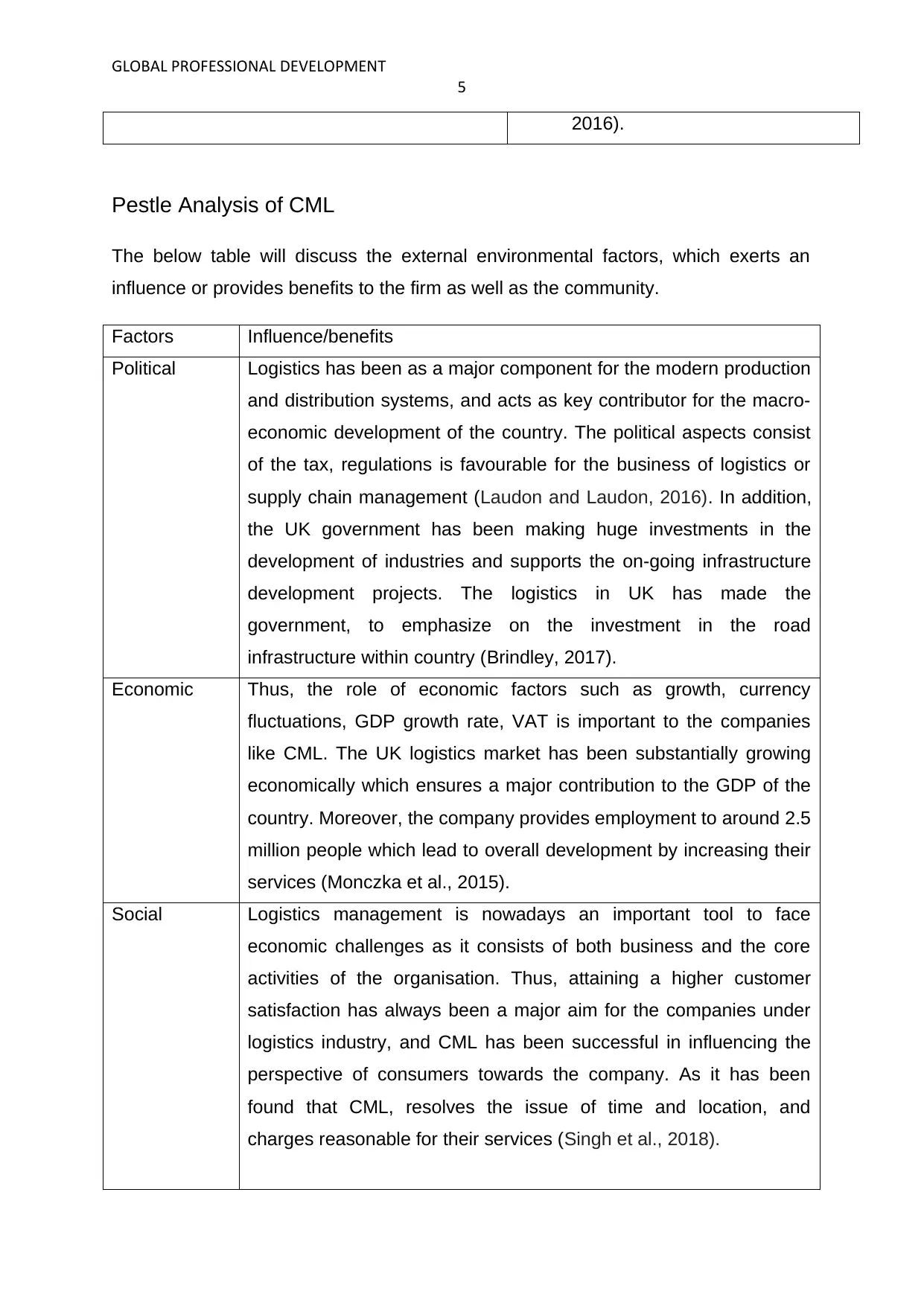
GLOBAL PROFESSIONAL DEVELOPMENT
5
2016).
Pestle Analysis of CML
The below table will discuss the external environmental factors, which exerts an
influence or provides benefits to the firm as well as the community.
Factors Influence/benefits
Political Logistics has been as a major component for the modern production
and distribution systems, and acts as key contributor for the macro-
economic development of the country. The political aspects consist
of the tax, regulations is favourable for the business of logistics or
supply chain management (Laudon and Laudon, 2016). In addition,
the UK government has been making huge investments in the
development of industries and supports the on-going infrastructure
development projects. The logistics in UK has made the
government, to emphasize on the investment in the road
infrastructure within country (Brindley, 2017).
Economic Thus, the role of economic factors such as growth, currency
fluctuations, GDP growth rate, VAT is important to the companies
like CML. The UK logistics market has been substantially growing
economically which ensures a major contribution to the GDP of the
country. Moreover, the company provides employment to around 2.5
million people which lead to overall development by increasing their
services (Monczka et al., 2015).
Social Logistics management is nowadays an important tool to face
economic challenges as it consists of both business and the core
activities of the organisation. Thus, attaining a higher customer
satisfaction has always been a major aim for the companies under
logistics industry, and CML has been successful in influencing the
perspective of consumers towards the company. As it has been
found that CML, resolves the issue of time and location, and
charges reasonable for their services (Singh et al., 2018).
5
2016).
Pestle Analysis of CML
The below table will discuss the external environmental factors, which exerts an
influence or provides benefits to the firm as well as the community.
Factors Influence/benefits
Political Logistics has been as a major component for the modern production
and distribution systems, and acts as key contributor for the macro-
economic development of the country. The political aspects consist
of the tax, regulations is favourable for the business of logistics or
supply chain management (Laudon and Laudon, 2016). In addition,
the UK government has been making huge investments in the
development of industries and supports the on-going infrastructure
development projects. The logistics in UK has made the
government, to emphasize on the investment in the road
infrastructure within country (Brindley, 2017).
Economic Thus, the role of economic factors such as growth, currency
fluctuations, GDP growth rate, VAT is important to the companies
like CML. The UK logistics market has been substantially growing
economically which ensures a major contribution to the GDP of the
country. Moreover, the company provides employment to around 2.5
million people which lead to overall development by increasing their
services (Monczka et al., 2015).
Social Logistics management is nowadays an important tool to face
economic challenges as it consists of both business and the core
activities of the organisation. Thus, attaining a higher customer
satisfaction has always been a major aim for the companies under
logistics industry, and CML has been successful in influencing the
perspective of consumers towards the company. As it has been
found that CML, resolves the issue of time and location, and
charges reasonable for their services (Singh et al., 2018).
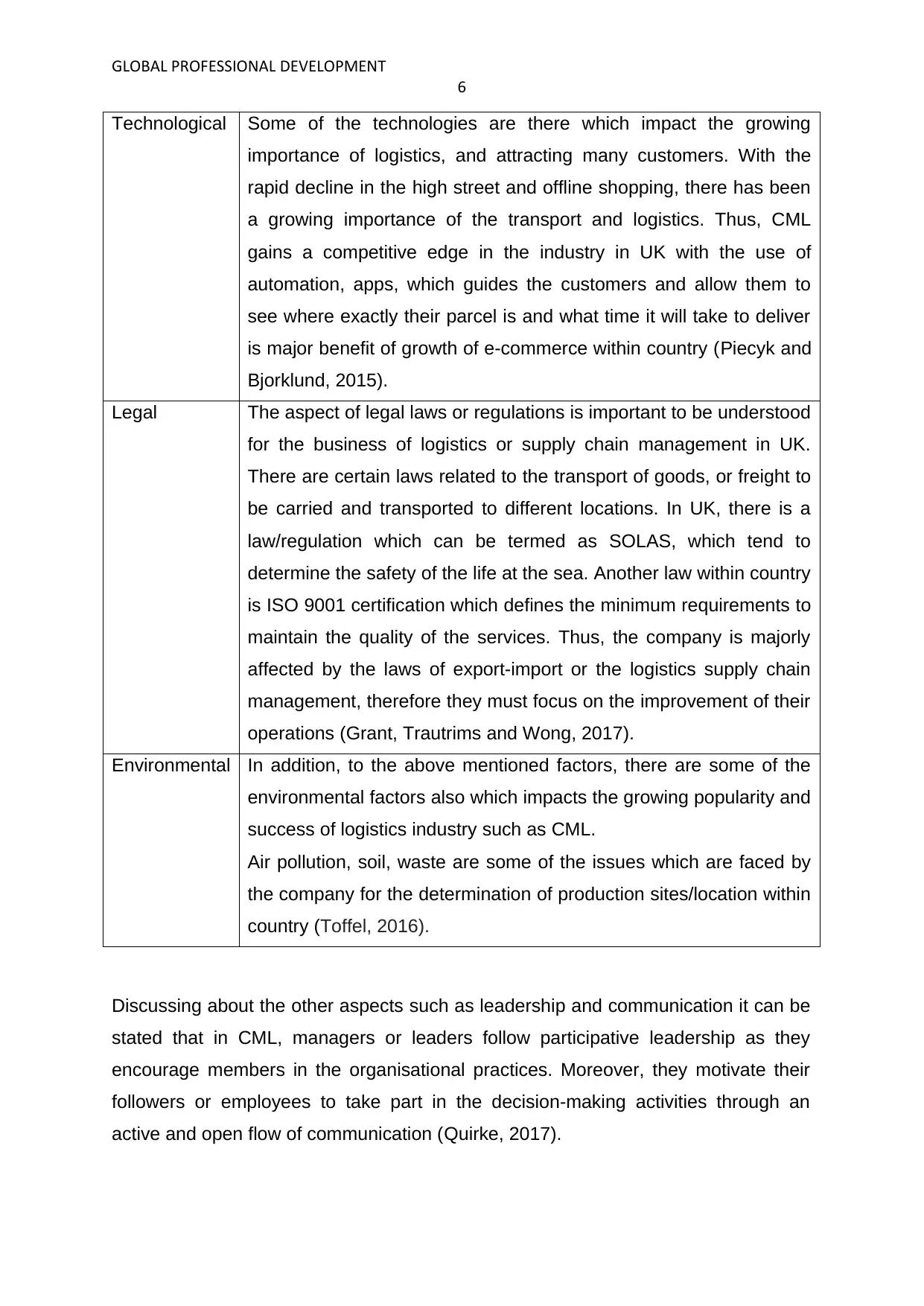
GLOBAL PROFESSIONAL DEVELOPMENT
6
Technological Some of the technologies are there which impact the growing
importance of logistics, and attracting many customers. With the
rapid decline in the high street and offline shopping, there has been
a growing importance of the transport and logistics. Thus, CML
gains a competitive edge in the industry in UK with the use of
automation, apps, which guides the customers and allow them to
see where exactly their parcel is and what time it will take to deliver
is major benefit of growth of e-commerce within country (Piecyk and
Bjorklund, 2015).
Legal The aspect of legal laws or regulations is important to be understood
for the business of logistics or supply chain management in UK.
There are certain laws related to the transport of goods, or freight to
be carried and transported to different locations. In UK, there is a
law/regulation which can be termed as SOLAS, which tend to
determine the safety of the life at the sea. Another law within country
is ISO 9001 certification which defines the minimum requirements to
maintain the quality of the services. Thus, the company is majorly
affected by the laws of export-import or the logistics supply chain
management, therefore they must focus on the improvement of their
operations (Grant, Trautrims and Wong, 2017).
Environmental In addition, to the above mentioned factors, there are some of the
environmental factors also which impacts the growing popularity and
success of logistics industry such as CML.
Air pollution, soil, waste are some of the issues which are faced by
the company for the determination of production sites/location within
country (Toffel, 2016).
Discussing about the other aspects such as leadership and communication it can be
stated that in CML, managers or leaders follow participative leadership as they
encourage members in the organisational practices. Moreover, they motivate their
followers or employees to take part in the decision-making activities through an
active and open flow of communication (Quirke, 2017).
6
Technological Some of the technologies are there which impact the growing
importance of logistics, and attracting many customers. With the
rapid decline in the high street and offline shopping, there has been
a growing importance of the transport and logistics. Thus, CML
gains a competitive edge in the industry in UK with the use of
automation, apps, which guides the customers and allow them to
see where exactly their parcel is and what time it will take to deliver
is major benefit of growth of e-commerce within country (Piecyk and
Bjorklund, 2015).
Legal The aspect of legal laws or regulations is important to be understood
for the business of logistics or supply chain management in UK.
There are certain laws related to the transport of goods, or freight to
be carried and transported to different locations. In UK, there is a
law/regulation which can be termed as SOLAS, which tend to
determine the safety of the life at the sea. Another law within country
is ISO 9001 certification which defines the minimum requirements to
maintain the quality of the services. Thus, the company is majorly
affected by the laws of export-import or the logistics supply chain
management, therefore they must focus on the improvement of their
operations (Grant, Trautrims and Wong, 2017).
Environmental In addition, to the above mentioned factors, there are some of the
environmental factors also which impacts the growing popularity and
success of logistics industry such as CML.
Air pollution, soil, waste are some of the issues which are faced by
the company for the determination of production sites/location within
country (Toffel, 2016).
Discussing about the other aspects such as leadership and communication it can be
stated that in CML, managers or leaders follow participative leadership as they
encourage members in the organisational practices. Moreover, they motivate their
followers or employees to take part in the decision-making activities through an
active and open flow of communication (Quirke, 2017).
Paraphrase This Document
Need a fresh take? Get an instant paraphrase of this document with our AI Paraphraser
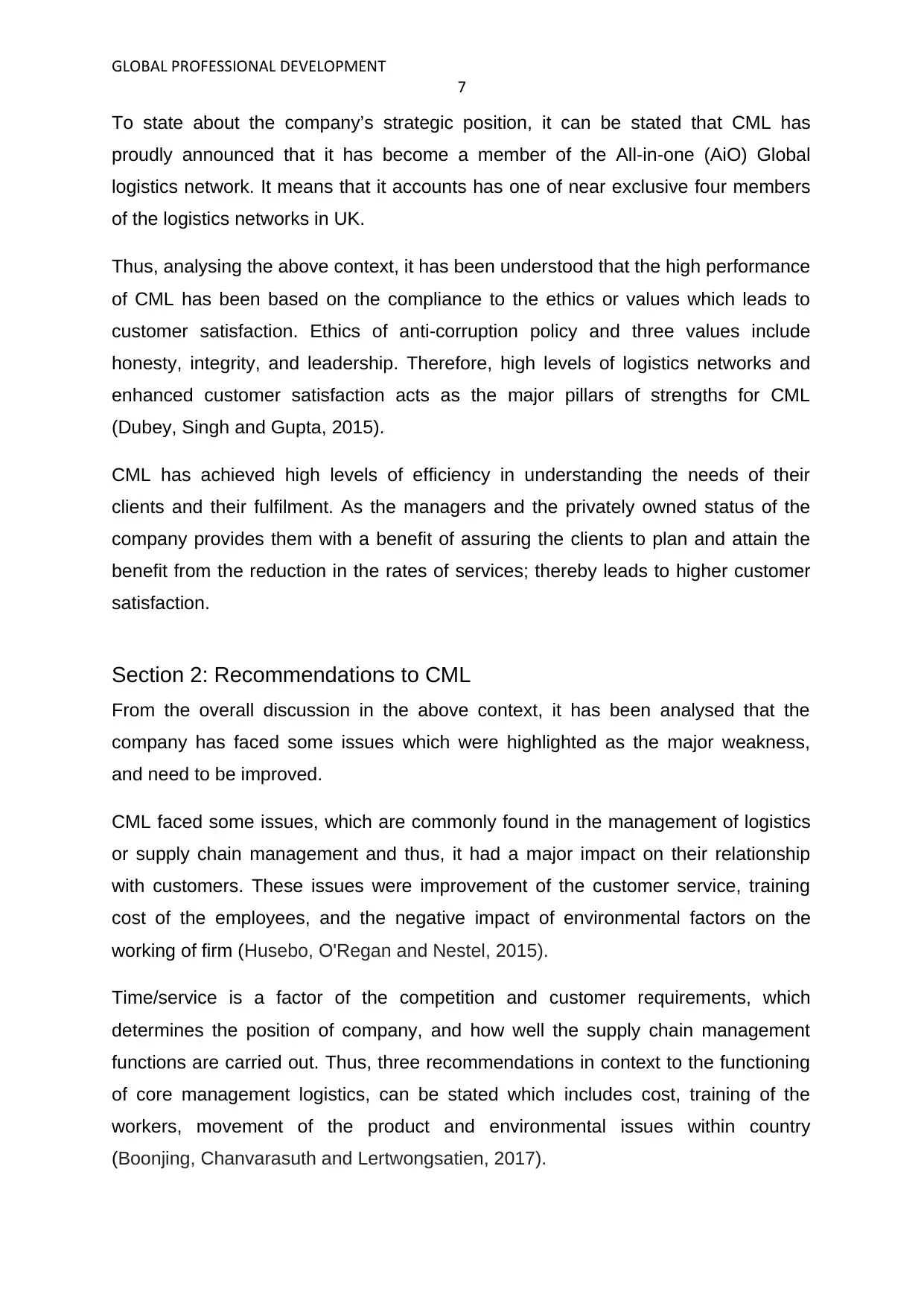
GLOBAL PROFESSIONAL DEVELOPMENT
7
To state about the company’s strategic position, it can be stated that CML has
proudly announced that it has become a member of the All-in-one (AiO) Global
logistics network. It means that it accounts has one of near exclusive four members
of the logistics networks in UK.
Thus, analysing the above context, it has been understood that the high performance
of CML has been based on the compliance to the ethics or values which leads to
customer satisfaction. Ethics of anti-corruption policy and three values include
honesty, integrity, and leadership. Therefore, high levels of logistics networks and
enhanced customer satisfaction acts as the major pillars of strengths for CML
(Dubey, Singh and Gupta, 2015).
CML has achieved high levels of efficiency in understanding the needs of their
clients and their fulfilment. As the managers and the privately owned status of the
company provides them with a benefit of assuring the clients to plan and attain the
benefit from the reduction in the rates of services; thereby leads to higher customer
satisfaction.
Section 2: Recommendations to CML
From the overall discussion in the above context, it has been analysed that the
company has faced some issues which were highlighted as the major weakness,
and need to be improved.
CML faced some issues, which are commonly found in the management of logistics
or supply chain management and thus, it had a major impact on their relationship
with customers. These issues were improvement of the customer service, training
cost of the employees, and the negative impact of environmental factors on the
working of firm (Husebo, O'Regan and Nestel, 2015).
Time/service is a factor of the competition and customer requirements, which
determines the position of company, and how well the supply chain management
functions are carried out. Thus, three recommendations in context to the functioning
of core management logistics, can be stated which includes cost, training of the
workers, movement of the product and environmental issues within country
(Boonjing, Chanvarasuth and Lertwongsatien, 2017).
7
To state about the company’s strategic position, it can be stated that CML has
proudly announced that it has become a member of the All-in-one (AiO) Global
logistics network. It means that it accounts has one of near exclusive four members
of the logistics networks in UK.
Thus, analysing the above context, it has been understood that the high performance
of CML has been based on the compliance to the ethics or values which leads to
customer satisfaction. Ethics of anti-corruption policy and three values include
honesty, integrity, and leadership. Therefore, high levels of logistics networks and
enhanced customer satisfaction acts as the major pillars of strengths for CML
(Dubey, Singh and Gupta, 2015).
CML has achieved high levels of efficiency in understanding the needs of their
clients and their fulfilment. As the managers and the privately owned status of the
company provides them with a benefit of assuring the clients to plan and attain the
benefit from the reduction in the rates of services; thereby leads to higher customer
satisfaction.
Section 2: Recommendations to CML
From the overall discussion in the above context, it has been analysed that the
company has faced some issues which were highlighted as the major weakness,
and need to be improved.
CML faced some issues, which are commonly found in the management of logistics
or supply chain management and thus, it had a major impact on their relationship
with customers. These issues were improvement of the customer service, training
cost of the employees, and the negative impact of environmental factors on the
working of firm (Husebo, O'Regan and Nestel, 2015).
Time/service is a factor of the competition and customer requirements, which
determines the position of company, and how well the supply chain management
functions are carried out. Thus, three recommendations in context to the functioning
of core management logistics, can be stated which includes cost, training of the
workers, movement of the product and environmental issues within country
(Boonjing, Chanvarasuth and Lertwongsatien, 2017).
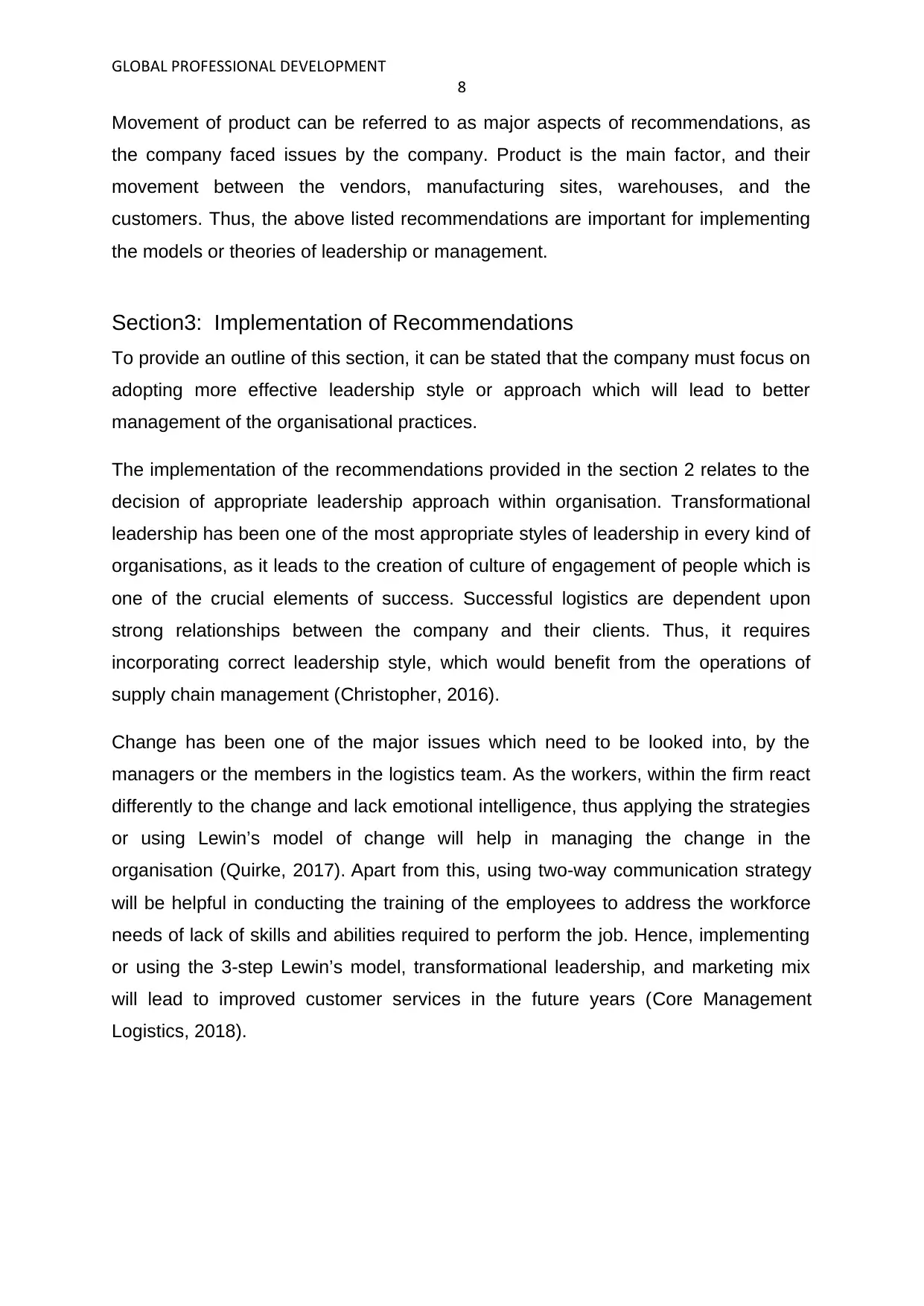
GLOBAL PROFESSIONAL DEVELOPMENT
8
Movement of product can be referred to as major aspects of recommendations, as
the company faced issues by the company. Product is the main factor, and their
movement between the vendors, manufacturing sites, warehouses, and the
customers. Thus, the above listed recommendations are important for implementing
the models or theories of leadership or management.
Section3: Implementation of Recommendations
To provide an outline of this section, it can be stated that the company must focus on
adopting more effective leadership style or approach which will lead to better
management of the organisational practices.
The implementation of the recommendations provided in the section 2 relates to the
decision of appropriate leadership approach within organisation. Transformational
leadership has been one of the most appropriate styles of leadership in every kind of
organisations, as it leads to the creation of culture of engagement of people which is
one of the crucial elements of success. Successful logistics are dependent upon
strong relationships between the company and their clients. Thus, it requires
incorporating correct leadership style, which would benefit from the operations of
supply chain management (Christopher, 2016).
Change has been one of the major issues which need to be looked into, by the
managers or the members in the logistics team. As the workers, within the firm react
differently to the change and lack emotional intelligence, thus applying the strategies
or using Lewin’s model of change will help in managing the change in the
organisation (Quirke, 2017). Apart from this, using two-way communication strategy
will be helpful in conducting the training of the employees to address the workforce
needs of lack of skills and abilities required to perform the job. Hence, implementing
or using the 3-step Lewin’s model, transformational leadership, and marketing mix
will lead to improved customer services in the future years (Core Management
Logistics, 2018).
8
Movement of product can be referred to as major aspects of recommendations, as
the company faced issues by the company. Product is the main factor, and their
movement between the vendors, manufacturing sites, warehouses, and the
customers. Thus, the above listed recommendations are important for implementing
the models or theories of leadership or management.
Section3: Implementation of Recommendations
To provide an outline of this section, it can be stated that the company must focus on
adopting more effective leadership style or approach which will lead to better
management of the organisational practices.
The implementation of the recommendations provided in the section 2 relates to the
decision of appropriate leadership approach within organisation. Transformational
leadership has been one of the most appropriate styles of leadership in every kind of
organisations, as it leads to the creation of culture of engagement of people which is
one of the crucial elements of success. Successful logistics are dependent upon
strong relationships between the company and their clients. Thus, it requires
incorporating correct leadership style, which would benefit from the operations of
supply chain management (Christopher, 2016).
Change has been one of the major issues which need to be looked into, by the
managers or the members in the logistics team. As the workers, within the firm react
differently to the change and lack emotional intelligence, thus applying the strategies
or using Lewin’s model of change will help in managing the change in the
organisation (Quirke, 2017). Apart from this, using two-way communication strategy
will be helpful in conducting the training of the employees to address the workforce
needs of lack of skills and abilities required to perform the job. Hence, implementing
or using the 3-step Lewin’s model, transformational leadership, and marketing mix
will lead to improved customer services in the future years (Core Management
Logistics, 2018).
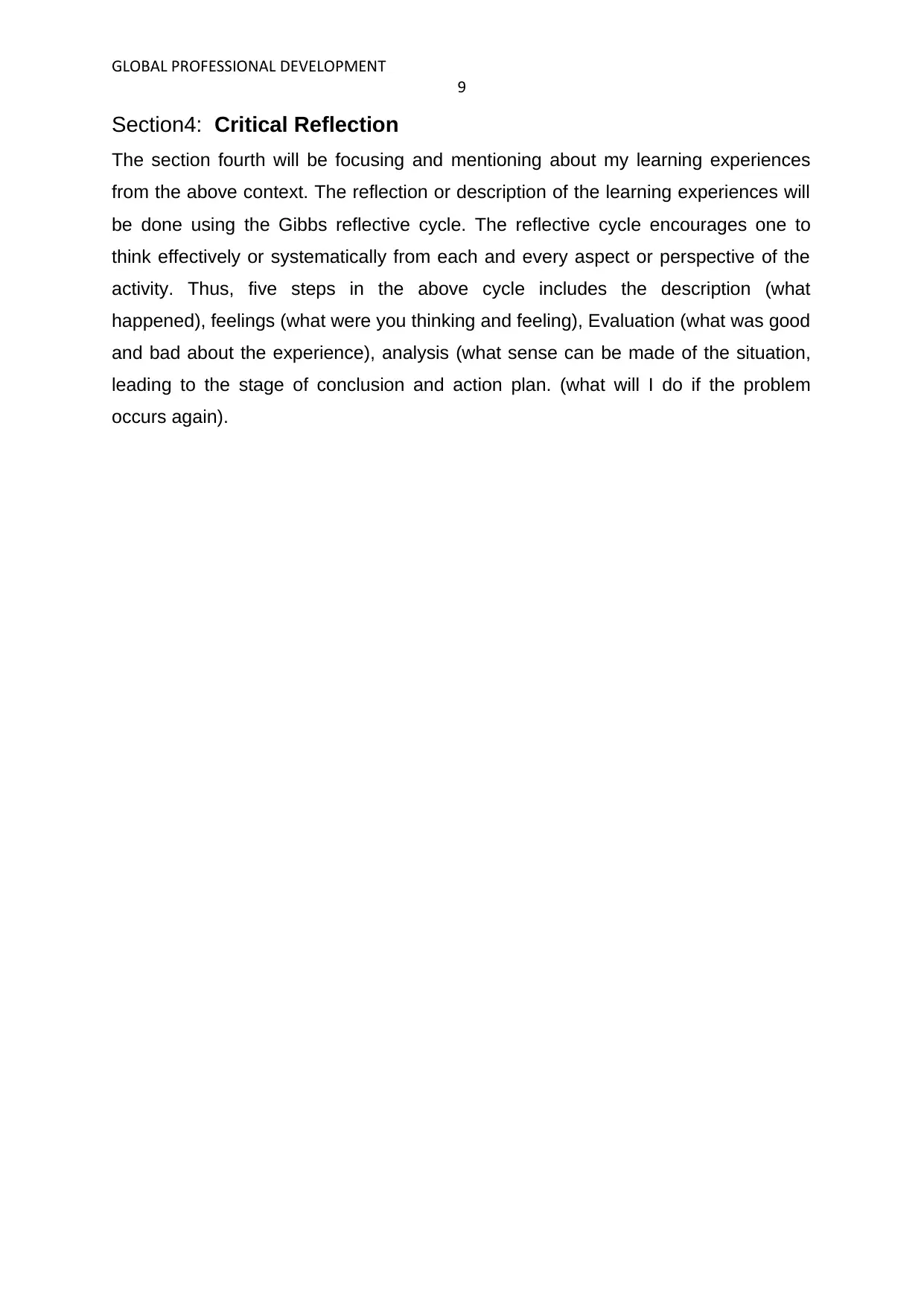
GLOBAL PROFESSIONAL DEVELOPMENT
9
Section4: Critical Reflection
The section fourth will be focusing and mentioning about my learning experiences
from the above context. The reflection or description of the learning experiences will
be done using the Gibbs reflective cycle. The reflective cycle encourages one to
think effectively or systematically from each and every aspect or perspective of the
activity. Thus, five steps in the above cycle includes the description (what
happened), feelings (what were you thinking and feeling), Evaluation (what was good
and bad about the experience), analysis (what sense can be made of the situation,
leading to the stage of conclusion and action plan. (what will I do if the problem
occurs again).
9
Section4: Critical Reflection
The section fourth will be focusing and mentioning about my learning experiences
from the above context. The reflection or description of the learning experiences will
be done using the Gibbs reflective cycle. The reflective cycle encourages one to
think effectively or systematically from each and every aspect or perspective of the
activity. Thus, five steps in the above cycle includes the description (what
happened), feelings (what were you thinking and feeling), Evaluation (what was good
and bad about the experience), analysis (what sense can be made of the situation,
leading to the stage of conclusion and action plan. (what will I do if the problem
occurs again).
Secure Best Marks with AI Grader
Need help grading? Try our AI Grader for instant feedback on your assignments.
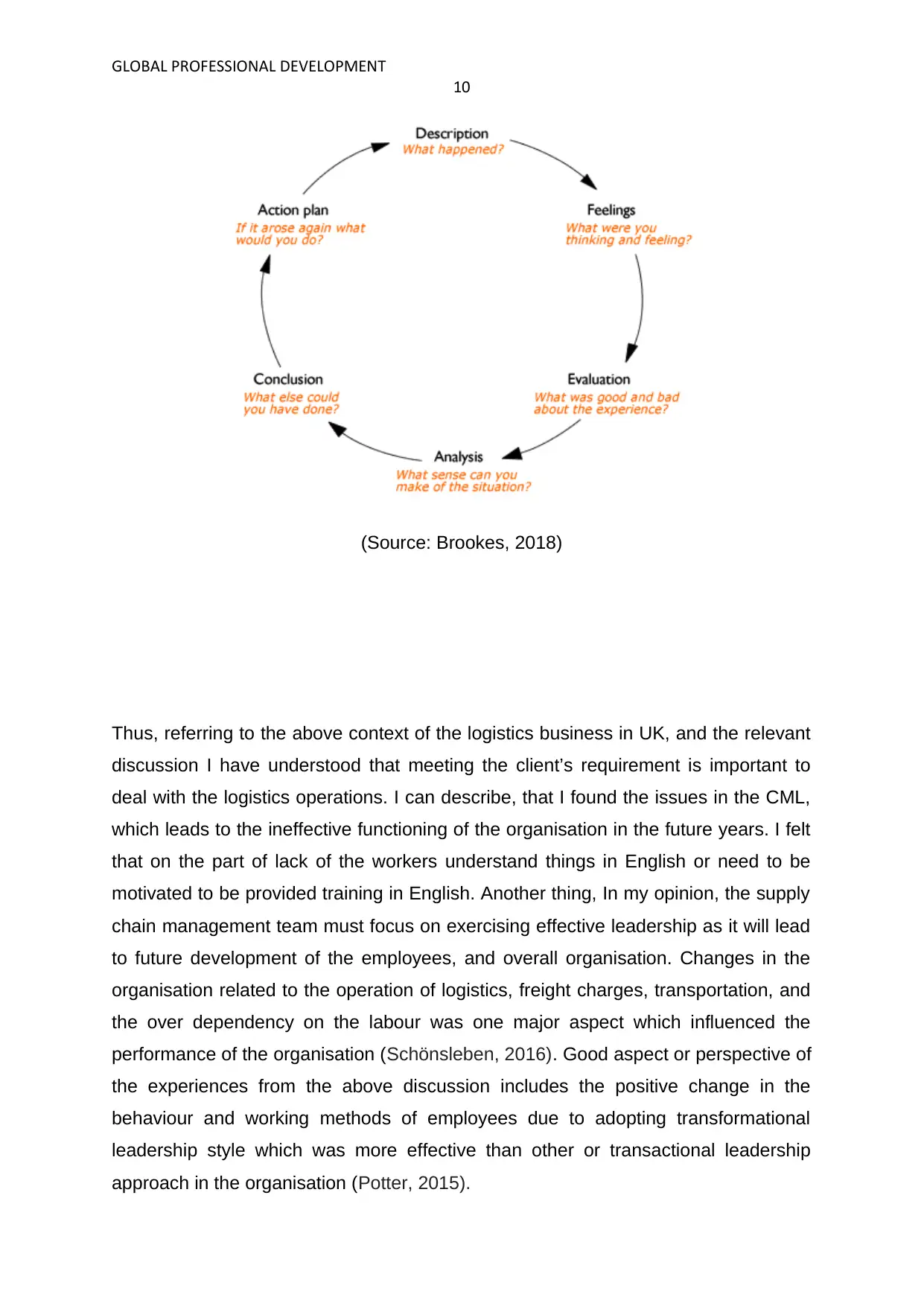
GLOBAL PROFESSIONAL DEVELOPMENT
10
(Source: Brookes, 2018)
Thus, referring to the above context of the logistics business in UK, and the relevant
discussion I have understood that meeting the client’s requirement is important to
deal with the logistics operations. I can describe, that I found the issues in the CML,
which leads to the ineffective functioning of the organisation in the future years. I felt
that on the part of lack of the workers understand things in English or need to be
motivated to be provided training in English. Another thing, In my opinion, the supply
chain management team must focus on exercising effective leadership as it will lead
to future development of the employees, and overall organisation. Changes in the
organisation related to the operation of logistics, freight charges, transportation, and
the over dependency on the labour was one major aspect which influenced the
performance of the organisation (Schönsleben, 2016). Good aspect or perspective of
the experiences from the above discussion includes the positive change in the
behaviour and working methods of employees due to adopting transformational
leadership style which was more effective than other or transactional leadership
approach in the organisation (Potter, 2015).
10
(Source: Brookes, 2018)
Thus, referring to the above context of the logistics business in UK, and the relevant
discussion I have understood that meeting the client’s requirement is important to
deal with the logistics operations. I can describe, that I found the issues in the CML,
which leads to the ineffective functioning of the organisation in the future years. I felt
that on the part of lack of the workers understand things in English or need to be
motivated to be provided training in English. Another thing, In my opinion, the supply
chain management team must focus on exercising effective leadership as it will lead
to future development of the employees, and overall organisation. Changes in the
organisation related to the operation of logistics, freight charges, transportation, and
the over dependency on the labour was one major aspect which influenced the
performance of the organisation (Schönsleben, 2016). Good aspect or perspective of
the experiences from the above discussion includes the positive change in the
behaviour and working methods of employees due to adopting transformational
leadership style which was more effective than other or transactional leadership
approach in the organisation (Potter, 2015).
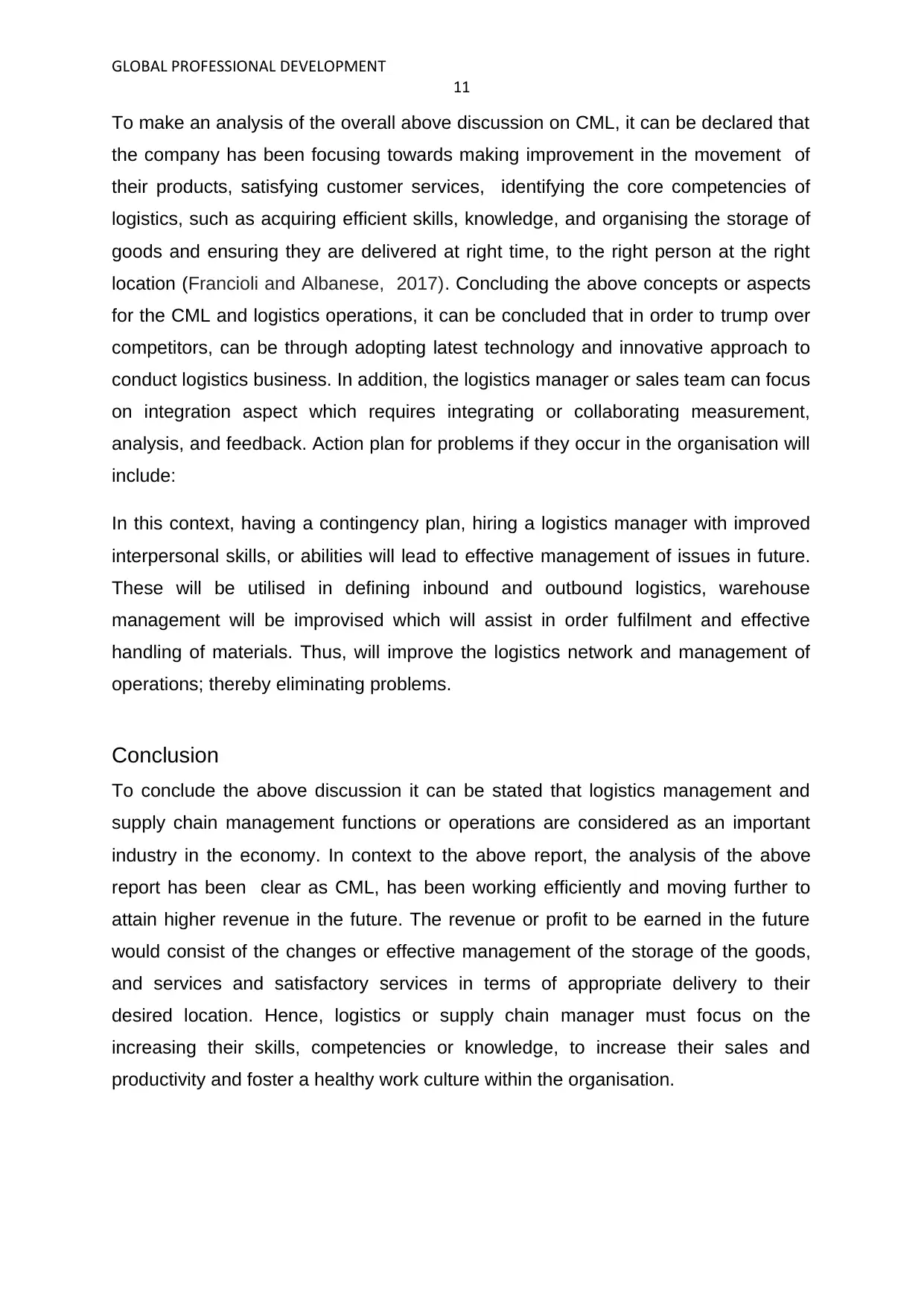
GLOBAL PROFESSIONAL DEVELOPMENT
11
To make an analysis of the overall above discussion on CML, it can be declared that
the company has been focusing towards making improvement in the movement of
their products, satisfying customer services, identifying the core competencies of
logistics, such as acquiring efficient skills, knowledge, and organising the storage of
goods and ensuring they are delivered at right time, to the right person at the right
location (Francioli and Albanese, 2017). Concluding the above concepts or aspects
for the CML and logistics operations, it can be concluded that in order to trump over
competitors, can be through adopting latest technology and innovative approach to
conduct logistics business. In addition, the logistics manager or sales team can focus
on integration aspect which requires integrating or collaborating measurement,
analysis, and feedback. Action plan for problems if they occur in the organisation will
include:
In this context, having a contingency plan, hiring a logistics manager with improved
interpersonal skills, or abilities will lead to effective management of issues in future.
These will be utilised in defining inbound and outbound logistics, warehouse
management will be improvised which will assist in order fulfilment and effective
handling of materials. Thus, will improve the logistics network and management of
operations; thereby eliminating problems.
Conclusion
To conclude the above discussion it can be stated that logistics management and
supply chain management functions or operations are considered as an important
industry in the economy. In context to the above report, the analysis of the above
report has been clear as CML, has been working efficiently and moving further to
attain higher revenue in the future. The revenue or profit to be earned in the future
would consist of the changes or effective management of the storage of the goods,
and services and satisfactory services in terms of appropriate delivery to their
desired location. Hence, logistics or supply chain manager must focus on the
increasing their skills, competencies or knowledge, to increase their sales and
productivity and foster a healthy work culture within the organisation.
11
To make an analysis of the overall above discussion on CML, it can be declared that
the company has been focusing towards making improvement in the movement of
their products, satisfying customer services, identifying the core competencies of
logistics, such as acquiring efficient skills, knowledge, and organising the storage of
goods and ensuring they are delivered at right time, to the right person at the right
location (Francioli and Albanese, 2017). Concluding the above concepts or aspects
for the CML and logistics operations, it can be concluded that in order to trump over
competitors, can be through adopting latest technology and innovative approach to
conduct logistics business. In addition, the logistics manager or sales team can focus
on integration aspect which requires integrating or collaborating measurement,
analysis, and feedback. Action plan for problems if they occur in the organisation will
include:
In this context, having a contingency plan, hiring a logistics manager with improved
interpersonal skills, or abilities will lead to effective management of issues in future.
These will be utilised in defining inbound and outbound logistics, warehouse
management will be improvised which will assist in order fulfilment and effective
handling of materials. Thus, will improve the logistics network and management of
operations; thereby eliminating problems.
Conclusion
To conclude the above discussion it can be stated that logistics management and
supply chain management functions or operations are considered as an important
industry in the economy. In context to the above report, the analysis of the above
report has been clear as CML, has been working efficiently and moving further to
attain higher revenue in the future. The revenue or profit to be earned in the future
would consist of the changes or effective management of the storage of the goods,
and services and satisfactory services in terms of appropriate delivery to their
desired location. Hence, logistics or supply chain manager must focus on the
increasing their skills, competencies or knowledge, to increase their sales and
productivity and foster a healthy work culture within the organisation.
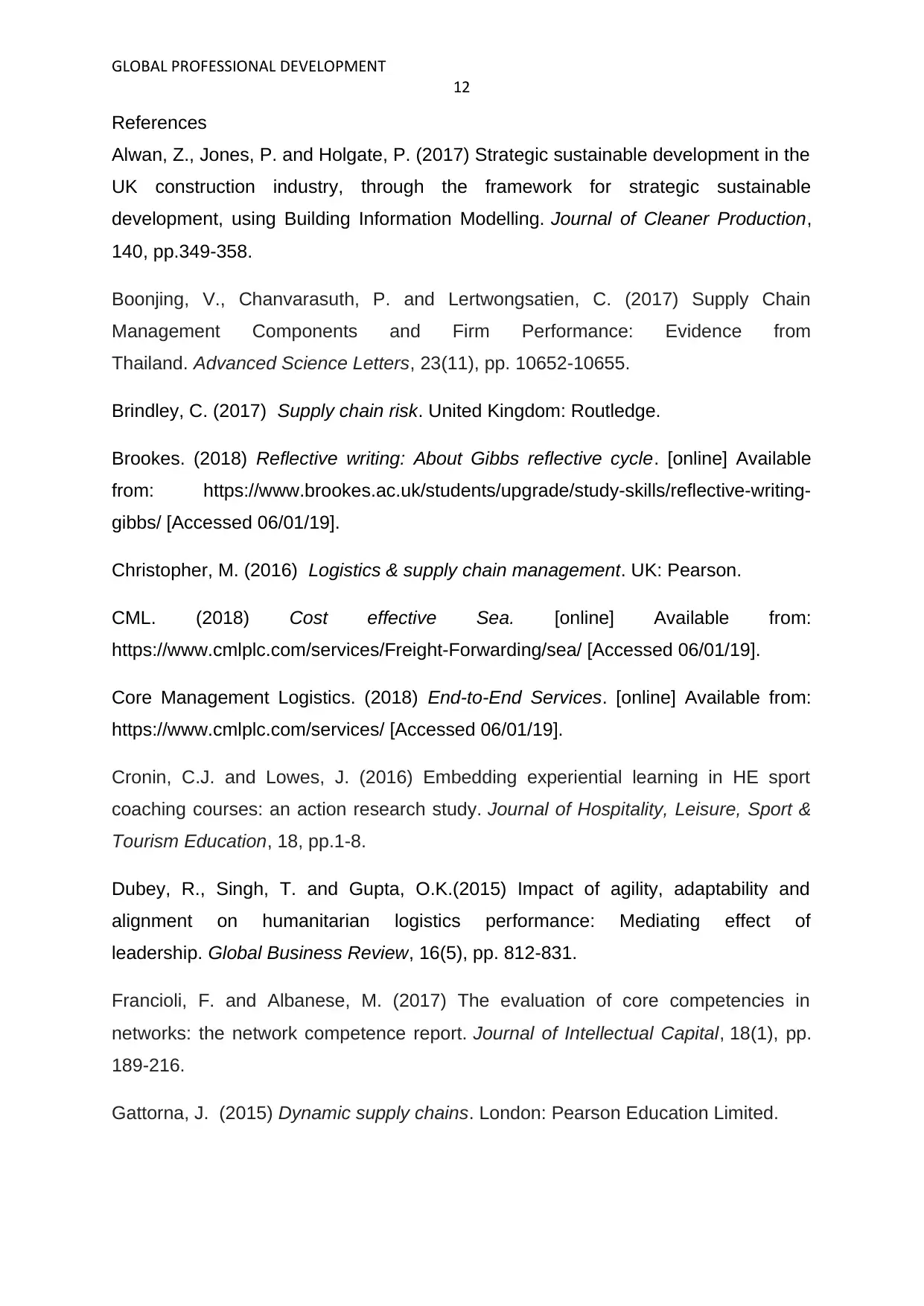
GLOBAL PROFESSIONAL DEVELOPMENT
12
References
Alwan, Z., Jones, P. and Holgate, P. (2017) Strategic sustainable development in the
UK construction industry, through the framework for strategic sustainable
development, using Building Information Modelling. Journal of Cleaner Production,
140, pp.349-358.
Boonjing, V., Chanvarasuth, P. and Lertwongsatien, C. (2017) Supply Chain
Management Components and Firm Performance: Evidence from
Thailand. Advanced Science Letters, 23(11), pp. 10652-10655.
Brindley, C. (2017) Supply chain risk. United Kingdom: Routledge.
Brookes. (2018) Reflective writing: About Gibbs reflective cycle. [online] Available
from: https://www.brookes.ac.uk/students/upgrade/study-skills/reflective-writing-
gibbs/ [Accessed 06/01/19].
Christopher, M. (2016) Logistics & supply chain management. UK: Pearson.
CML. (2018) Cost effective Sea. [online] Available from:
https://www.cmlplc.com/services/Freight-Forwarding/sea/ [Accessed 06/01/19].
Core Management Logistics. (2018) End-to-End Services. [online] Available from:
https://www.cmlplc.com/services/ [Accessed 06/01/19].
Cronin, C.J. and Lowes, J. (2016) Embedding experiential learning in HE sport
coaching courses: an action research study. Journal of Hospitality, Leisure, Sport &
Tourism Education, 18, pp.1-8.
Dubey, R., Singh, T. and Gupta, O.K.(2015) Impact of agility, adaptability and
alignment on humanitarian logistics performance: Mediating effect of
leadership. Global Business Review, 16(5), pp. 812-831.
Francioli, F. and Albanese, M. (2017) The evaluation of core competencies in
networks: the network competence report. Journal of Intellectual Capital, 18(1), pp.
189-216.
Gattorna, J. (2015) Dynamic supply chains. London: Pearson Education Limited.
12
References
Alwan, Z., Jones, P. and Holgate, P. (2017) Strategic sustainable development in the
UK construction industry, through the framework for strategic sustainable
development, using Building Information Modelling. Journal of Cleaner Production,
140, pp.349-358.
Boonjing, V., Chanvarasuth, P. and Lertwongsatien, C. (2017) Supply Chain
Management Components and Firm Performance: Evidence from
Thailand. Advanced Science Letters, 23(11), pp. 10652-10655.
Brindley, C. (2017) Supply chain risk. United Kingdom: Routledge.
Brookes. (2018) Reflective writing: About Gibbs reflective cycle. [online] Available
from: https://www.brookes.ac.uk/students/upgrade/study-skills/reflective-writing-
gibbs/ [Accessed 06/01/19].
Christopher, M. (2016) Logistics & supply chain management. UK: Pearson.
CML. (2018) Cost effective Sea. [online] Available from:
https://www.cmlplc.com/services/Freight-Forwarding/sea/ [Accessed 06/01/19].
Core Management Logistics. (2018) End-to-End Services. [online] Available from:
https://www.cmlplc.com/services/ [Accessed 06/01/19].
Cronin, C.J. and Lowes, J. (2016) Embedding experiential learning in HE sport
coaching courses: an action research study. Journal of Hospitality, Leisure, Sport &
Tourism Education, 18, pp.1-8.
Dubey, R., Singh, T. and Gupta, O.K.(2015) Impact of agility, adaptability and
alignment on humanitarian logistics performance: Mediating effect of
leadership. Global Business Review, 16(5), pp. 812-831.
Francioli, F. and Albanese, M. (2017) The evaluation of core competencies in
networks: the network competence report. Journal of Intellectual Capital, 18(1), pp.
189-216.
Gattorna, J. (2015) Dynamic supply chains. London: Pearson Education Limited.
Paraphrase This Document
Need a fresh take? Get an instant paraphrase of this document with our AI Paraphraser

GLOBAL PROFESSIONAL DEVELOPMENT
13
Grant, D.B., Trautrims, A. and Wong, C.Y. (2017) Sustainable logistics and supply
chain management: principles and practices for sustainable operations and
management. United States: Kogan Page Publishers.
Husebø, S.E., O'Regan, S. and Nestel, D. (2015) Reflective practice and its role in
simulation. Clinical Simulation in Nursing, 11(8), pp.368-375.
Kucukaltan, B., Irani, Z. and Aktas, E. (2016) A decision support model for
identification and prioritization of key performance indicators in the logistics
industry. Computers in Human Behaviour, 65, pp. 346-358.
Lambert, D.M. and Enz, M.G. (2017) Issues in supply chain management: Progress
and potential. Industrial Marketing Management, 62, pp. 1-16.
Laudon, K.C. and Laudon, J.P. (2016) Management information system. Australia:
Pearson Education India.
Monczka, R.M., Handfield, R.B., Giunipero, L.C. and Patterson, J.L.
(2015) Purchasing and supply chain management. United States: Cengage
Learning.
Piecyk, M.I. and Bjorklund, M. (2015) Logistics service providers and corporate
social responsibility: sustainability reporting in the logistics industry. International
Journal of Physical Distribution & Logistics Management, 45(5), pp. 459-485.
Potter, C. (2015) Leadership development: an applied comparison of Gibbs’
Reflective Cycle and Scharmer’s Theory U. Industrial and Commercial
Training, 47(6), pp.336-342.
Quirke, B. (2017) Making the connections: using internal communication to turn
strategy into action. United Kingdom: Routledge.
Schönsleben, P. (2016) Integral logistics management: operations and supply chain
management within and across companies. United Kingdom: CRC Press.
Schönsleben, P. (2016) Integral logistics management: operations and supply chain
management within and across companies. United States: CRC Press.
13
Grant, D.B., Trautrims, A. and Wong, C.Y. (2017) Sustainable logistics and supply
chain management: principles and practices for sustainable operations and
management. United States: Kogan Page Publishers.
Husebø, S.E., O'Regan, S. and Nestel, D. (2015) Reflective practice and its role in
simulation. Clinical Simulation in Nursing, 11(8), pp.368-375.
Kucukaltan, B., Irani, Z. and Aktas, E. (2016) A decision support model for
identification and prioritization of key performance indicators in the logistics
industry. Computers in Human Behaviour, 65, pp. 346-358.
Lambert, D.M. and Enz, M.G. (2017) Issues in supply chain management: Progress
and potential. Industrial Marketing Management, 62, pp. 1-16.
Laudon, K.C. and Laudon, J.P. (2016) Management information system. Australia:
Pearson Education India.
Monczka, R.M., Handfield, R.B., Giunipero, L.C. and Patterson, J.L.
(2015) Purchasing and supply chain management. United States: Cengage
Learning.
Piecyk, M.I. and Bjorklund, M. (2015) Logistics service providers and corporate
social responsibility: sustainability reporting in the logistics industry. International
Journal of Physical Distribution & Logistics Management, 45(5), pp. 459-485.
Potter, C. (2015) Leadership development: an applied comparison of Gibbs’
Reflective Cycle and Scharmer’s Theory U. Industrial and Commercial
Training, 47(6), pp.336-342.
Quirke, B. (2017) Making the connections: using internal communication to turn
strategy into action. United Kingdom: Routledge.
Schönsleben, P. (2016) Integral logistics management: operations and supply chain
management within and across companies. United Kingdom: CRC Press.
Schönsleben, P. (2016) Integral logistics management: operations and supply chain
management within and across companies. United States: CRC Press.

GLOBAL PROFESSIONAL DEVELOPMENT
14
Singh, M.K., Kumar, H., Gupta, M.P. and Madaan, J.(2018) A Glimpse of
Sustainable Electronics Manufacturing for India: A Study Using PEST-SWOT
Analysis. In Global Value Chains, Flexibility and Sustainability (pp. 271-281).
Singapore: Springer.
Toffel, M.W. (2016) Enhancing the practical relevance of research. Production and
Operations Management, 25(9), pp.1493-1505.
Wang, G., Gunasekaran, A., Ngai, E.W. and Papadopoulos, T. (2016) Big data
analytics in logistics and supply chain management: Certain investigations for
research and applications. International Journal of Production Economics, 176, pp.
98-110.
Zach, F. (2016) Collaboration for innovation in tourism organizations: leadership
support, innovation formality, and communication. Journal of Hospitality & Tourism
Research, 40(3), pp. 271-290.
14
Singh, M.K., Kumar, H., Gupta, M.P. and Madaan, J.(2018) A Glimpse of
Sustainable Electronics Manufacturing for India: A Study Using PEST-SWOT
Analysis. In Global Value Chains, Flexibility and Sustainability (pp. 271-281).
Singapore: Springer.
Toffel, M.W. (2016) Enhancing the practical relevance of research. Production and
Operations Management, 25(9), pp.1493-1505.
Wang, G., Gunasekaran, A., Ngai, E.W. and Papadopoulos, T. (2016) Big data
analytics in logistics and supply chain management: Certain investigations for
research and applications. International Journal of Production Economics, 176, pp.
98-110.
Zach, F. (2016) Collaboration for innovation in tourism organizations: leadership
support, innovation formality, and communication. Journal of Hospitality & Tourism
Research, 40(3), pp. 271-290.
1 out of 15
Related Documents
Your All-in-One AI-Powered Toolkit for Academic Success.
+13062052269
info@desklib.com
Available 24*7 on WhatsApp / Email
![[object Object]](/_next/static/media/star-bottom.7253800d.svg)
Unlock your academic potential
© 2024 | Zucol Services PVT LTD | All rights reserved.




